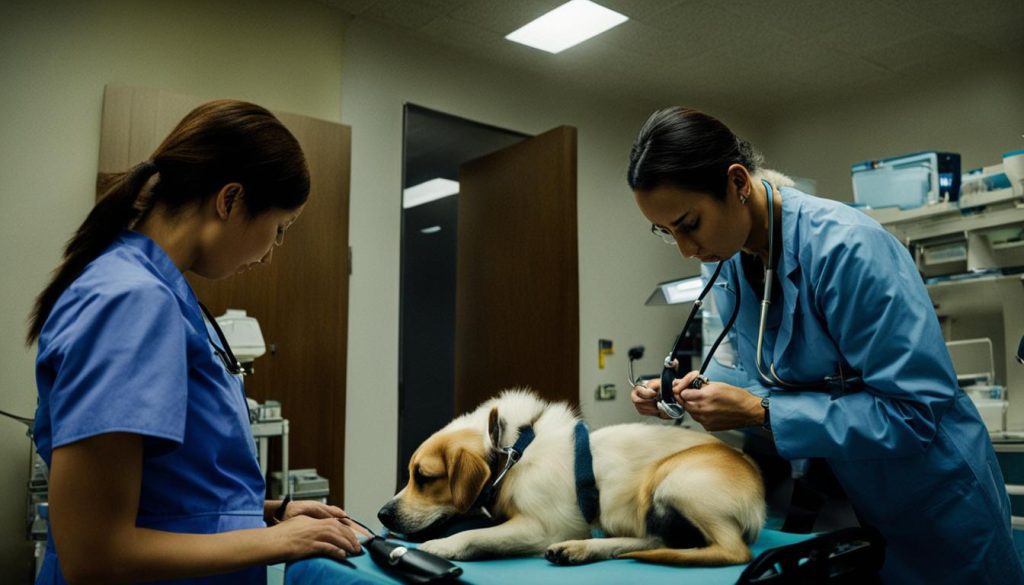Hello, I’m here to provide you with a comprehensive guide on Addison’s disease in dogs, specifically focusing on their life expectancy. Addison’s disease, also known as hypoadrenocorticism, is a serious condition that affects the adrenal glands of dogs. If left untreated, it can lead to complications and even death. However, with appropriate treatment and management, dogs diagnosed with Addison’s disease can live normal and fulfilling lives.
Addison’s disease occurs when the adrenal glands fail to produce enough hormones, specifically aldosterone and cortisol, which are essential for regulating the body’s internal organs and systems. The most common cause of Addison’s disease in dogs is an autoimmune process, where the dog’s own immune system mistakenly attacks and destroys the adrenal tissue. Other causes can include adrenal gland destruction, tumors, or side effects of certain medications.
While the exact cause of Addison’s disease is not fully understood, it can affect any dog, regardless of age, gender, or breed. However, certain breeds may be more predisposed to the disease, such as standard poodles, West Highland white terriers, Great Danes, bearded collies, and Portuguese water dogs.
Early diagnosis and proper management are crucial in ensuring a dog’s longevity and quality of life with Addison’s disease. In this guide, we will explore the causes, symptoms, diagnosis, treatment, and how to prevent this disease in dogs. By understanding and addressing these aspects, we can proactively support the well-being of our furry friends with Addison’s disease.
Key Takeaways:
- Addison’s disease is a serious condition that affects the adrenal glands of dogs.
- With proper treatment and management, dogs with Addison’s disease can lead normal lives.
- The disease is primarily caused by an autoimmune process, but can also be triggered by adrenal gland destruction, tumors, or certain medications.
- Early diagnosis and proper management are key to ensuring a dog’s longevity and quality of life.
- Certain breeds may be more predisposed to Addison’s disease.
Causes of Addison’s Disease in Dogs
The exact cause of Addison’s disease in dogs is not fully understood, but it is believed to be primarily caused by an autoimmune process. In this process, the dog’s own immune system mistakenly attacks and destroys the adrenal tissue. This autoimmune response leads to a deficiency in essential hormones, such as cortisol and aldosterone, which are produced by the adrenal glands. Consequently, the body’s ability to regulate internal organs and systems is compromised, resulting in the development of Addison’s disease.
Another potential cause of Addison’s disease in dogs is adrenal gland destruction. This can occur due to various factors, including the presence of tumors, metastasis, hemorrhage, or infarction. These conditions contribute to the physical damage and impairment of the adrenal glands, causing them to malfunction and result in Addison’s disease.
Additionally, certain medications can induce Addison’s disease in dogs by interfering with adrenal hormone production. Drugs like mitotane or trilostane, commonly used in the treatment of other conditions, can inhibit the adrenal glands’ ability to produce hormones. As a consequence, the dog may develop Addison’s disease due to the medication’s side effects.
While the specific triggers may vary, any factor that disrupts the function of the adrenal glands and impairs the production of cortisol and aldosterone can potentially lead to the development of Addison’s disease in dogs.
To better understand the causes of Addison’s disease in dogs, it is important to consult with a veterinarian who can provide a comprehensive evaluation and diagnostic process. By identifying the underlying cause, appropriate treatment and management strategies can be implemented to improve the dog’s well-being and quality of life.
Symptoms of Addison’s Disease in Dogs
Diagnosing Addison’s disease in dogs can be challenging due to its vague symptoms that often mimic other conditions. However, recognizing the signs is crucial for early detection and proper management of the disease.
- Recurrent bouts of gastroenteritis: Dogs with Addison’s disease may experience frequent episodes of inflammation in the gastrointestinal tract, resulting in symptoms such as diarrhea, vomiting, and abdominal discomfort.
- Poor appetite: Dogs may show a decreased interest in food, leading to weight loss and malnutrition. This can be a result of the hormonal imbalances caused by the disease.
- Slow loss of body condition: Addison’s disease can cause a gradual deterioration of muscle mass and overall body condition. Dogs may appear weak and emaciated over time.
- Inability to respond to stress: Dogs with Addison’s disease have impaired adrenal function, making them unable to cope with stressors. They may show lethargy, weakness, and an overall lack of energy.
Dogs with Addison’s disease may also experience imbalances in serum levels of sodium, chloride, and potassium. These electrolyte imbalances can affect the kidneys, leading to problems with the heart and circulatory system.
Additionally, cortisol, a hormone produced by the adrenal glands, plays a vital role in various bodily functions. A reduction in cortisol production can lead to disruptions in glucose regulation, metabolism, blood pressure control, inflammation suppression, and red blood cell formation. Consequently, dogs with Addison’s disease may exhibit a wide range of symptoms related to these functions.
As the symptoms of Addison’s disease can be subtle and easily overlooked, it is important for dog owners to consult a veterinarian if they notice any concerning changes in their pet’s behavior, appetite, or overall health. Early detection and proper management are essential for ensuring the well-being and longevity of dogs with Addison’s disease.
Diagnosing Addison’s Disease in Dogs
Addison’s disease in dogs can be diagnosed through various tests, particularly during an Addisonian crisis, which is a severe stage of the disease characterized by shock and collapse. To confirm the diagnosis and rule out other possibilities, veterinarians typically perform a series of tests.
Firstly, blood work is conducted to assess the complete blood count, biochemistry, and electrolyte levels. Anemia, elevated potassium and urea levels, as well as imbalances in sodium, chloride, and calcium, can indicate the presence of Addison’s disease. Additionally, a urinalysis may be performed to further evaluate the dog’s condition.
The adrenocorticotropic hormone (ACTH) stimulation test is considered the definitive diagnostic test for Addison’s disease in dogs. This test measures the concentration of cortisol, a hormone produced by the adrenal glands, before and after the administration of synthetic ACTH. Dogs with Addison’s disease will have low cortisol levels both before and after the stimulation, indicating dysfunction in the adrenal glands.
Diagnosing Addison’s disease accurately is crucial for initiating appropriate treatment and management strategies. With the help of blood work, urinalysis, and the ACTH stimulation test, veterinarians can confirm a diagnosis and develop an effective plan to address the dog’s specific needs.

Treating Addison’s Disease in Dogs
Once a dog is diagnosed with Addison’s disease, the immediate priority is to stabilize the dog if they are in an acute Addisonian crisis. This involves hospitalization and intensive therapy to manage the symptoms and restore balance to the body.
Once the crisis is resolved, long-term treatment revolves around providing replacement hormones to compensate for the adrenal gland’s deficiency. Typically, dogs with Addison’s disease are prescribed an injectable mineralocorticoid like desoxycorticosterone pivalate (DOCP) monthly and a daily steroid like prednisone to replace aldosterone and cortisol, respectively.
The dosage of the medication may need to be adjusted over time, especially during periods of stress. Regular monitoring through blood work is essential to ensure the medication’s effectiveness and make any necessary adjustments. It is important for owners to follow their veterinarian’s guidance and not make any changes to the medication or brand without veterinary consultation, as it can disrupt hormonal balance and lead to complications.
Lifelong treatment is necessary for dogs with Addison’s disease, and regular veterinary check-ups are recommended to ensure their well-being and health.
Preventing Addison’s Disease in Dogs
In most cases, Addison’s disease in dogs cannot be prevented as it is primarily caused by an autoimmune process. However, there are preventive measures that owners can take to minimize the risk and ensure the well-being of their dogs.
1. Follow Your Veterinarian’s Instructions
- Always follow your veterinarian’s instructions regarding your dog’s medication, dosage, and any necessary adjustments.
- If your dog is on medications for conditions like Cushing’s disease, such as mitotane or trilostane, be aware of the symptoms of Addison’s disease and prevent an accidental medication-induced Addisonian crisis.
2. Avoid Abrupt Drug Withdrawal
- Abrupt withdrawal of certain drugs can trigger Addison’s disease. It is essential to gradually taper off medications under veterinary supervision.
3. Be Aware of Symptoms
- Stay vigilant and familiarize yourself with the symptoms of Addison’s disease in dogs.
- If you notice any unusual signs or symptoms, such as lethargy, weakness, vomiting, or diarrhea, seek veterinary care promptly.
4. Prevent Accidental Overdose
- Accidental overdose can lead to complications. Ensure that medications are stored securely and not accessible to your dog.
- Be cautious when administering medications to your dog to prevent accidental overdose.
By being proactive, observant, and cautious, you can minimize the risk of Addison’s disease in dogs and ensure the well-being of your furry companion.
Managing Addison’s Disease in Dogs
Managing Addison’s disease in dogs requires a long-term commitment and proper care. The key to successful management is providing hormone replacement therapy and regular monitoring.
Dogs with Addison’s disease will need to receive replacement hormones for the rest of their lives. This hormone replacement therapy ensures that the dog’s body maintains the necessary levels of aldosterone and cortisol. These hormones are essential for regulating various bodily functions.
To ensure the optimal dosage of replacement hormones, frequent veterinary visits are necessary, especially in the initial stages. During these visits, hormone and electrolyte levels are monitored, allowing veterinarians to make any necessary adjustments to medication dosages.
Once the hormone replacement therapy is established, dogs with Addison’s disease typically require monthly shots of replacement hormones. In some cases, additional medications or treatments may be prescribed by the veterinarian to further support the dog’s overall health.
In addition to medication management, stress management plays a crucial role in managing Addison’s disease in dogs. Stress can exacerbate symptoms and potentially lead to complications. Therefore, it is important for owners to be mindful of their dog’s stress triggers and make efforts to minimize stressful situations.
Regular check-ups with the veterinarian are vital for dogs with Addison’s disease. These check-ups allow for the assessment of the treatment plan’s effectiveness and the dog’s overall health and well-being. Through regular monitoring, any necessary adjustments to the treatment plan can be made, ensuring optimal care for dogs with Addison’s disease.
Summary:
- Provide hormone replacement therapy to manage Addison’s disease in dogs.
- Regularly monitor hormone and electrolyte levels for dosage adjustments.
- Monthly shots of replacement hormones are typically required.
- Follow stress management techniques to minimize symptoms.
- Attend regular veterinary check-ups to assess treatment effectiveness and make any necessary adjustments.
Conclusion
Addison’s disease in dogs is a serious condition that requires early diagnosis and proper management for the best possible outcome. With appropriate treatment and commitment to lifelong care, dogs with Addison’s disease are expected to have normal lifespans. It is crucial for owners to be aware of the symptoms of Addison’s disease and promptly seek veterinary care if their dog exhibits any concerning signs.
Once diagnosed, adherence to the prescribed treatment plan, including regular medication administration and veterinary check-ups, is essential to ensure the dog’s health and well-being. By working closely with their veterinarian and providing the necessary care, owners can help their dogs live long, happy lives despite the challenges posed by Addison’s disease. Remember, proper management is key to maintaining a good quality of life for dogs with Addison’s disease.
To optimize treatment outcomes, owners should commit to lifelong treatment and closely follow their veterinarian’s guidance. It is important to administer medications as prescribed, adjust dosages if required, and attend regular veterinary check-ups. By investing in the long-term care of their dogs and managing the disease effectively, owners can provide the best chances for a healthy and fulfilling life for their beloved canine companions.
FAQ
What is Addison’s disease in dogs?
Addison’s disease, also known as hypoadrenocorticism, is a serious disease in dogs that affects their adrenal glands. It occurs when the adrenal glands fail to produce enough hormones, particularly aldosterone and cortisol, which are essential for regulating the body’s internal organs and systems.
What are the causes of Addison’s disease in dogs?
The exact cause of Addison’s disease in dogs is not fully understood. It is believed to be primarily caused by an autoimmune process in which the dog’s own immune system mistakenly attacks and destroys the adrenal tissue. Other possible causes include adrenal gland destruction, often as a result of tumors, metastasis, hemorrhage, or infarction, as well as certain medications that inhibit adrenal hormone production.
What are the symptoms of Addison’s disease in dogs?
The symptoms of Addison’s disease in dogs can be vague and often mimic other conditions. Common symptoms include recurrent bouts of gastroenteritis, poor appetite, slow loss of body condition, and an inability to respond appropriately to stress. Dogs with Addison’s disease may also experience changes in serum levels of sodium, chloride, and potassium, which can affect the kidneys and lead to problems with the heart and circulatory system.
How is Addison’s disease in dogs diagnosed?
Addison’s disease is often diagnosed during an Addisonian crisis, which is a life-threatening stage of the disease characterized by shock and collapse. To confirm the diagnosis and rule out other possibilities, veterinarians perform a series of tests including blood work, urinalysis, and the adrenocorticotropic hormone (ACTH) stimulation test.
How is Addison’s disease in dogs treated?
Once a dog is diagnosed with Addison’s disease, the immediate priority is to stabilize the dog if they are in an acute Addisonian crisis. This involves hospitalization and intensive therapy. Long-term treatment involves providing replacement hormones to compensate for the adrenal gland’s deficiency. Dogs with Addison’s disease are typically prescribed an injectable mineralocorticoid like desoxycorticosterone pivalate (DOCP) monthly and a daily steroid like prednisone to replace aldosterone and cortisol, respectively.
Can Addison’s disease in dogs be prevented?
In most cases, Addison’s disease in dogs cannot be prevented as it is primarily caused by an autoimmune process. However, there are preventive measures that owners can take, such as following their veterinarian’s instructions regarding medication, avoiding abrupt withdrawal of certain drugs, and being aware of the symptoms of Addison’s disease to prevent an accidental medication-induced Addisonian crisis.
How should Addison’s disease in dogs be managed?
Managing Addison’s disease in dogs requires long-term commitment and proper care, including hormone replacement therapy and stress management. Dogs with Addison’s disease will need to receive replacement hormones for the rest of their lives, and medication dosages may need to be adjusted periodically. Regular check-ups with the veterinarian are important to monitor the dog’s health and well-being.






